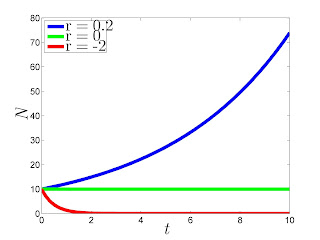Exponential Growth Model

The number of units Nt (e.g. organisms) in time t (or next t generations), is proportional to its initial number of units N0 and the instantaneous growth rate r, i.e.
If r > 0, N increases. If r < 0, N decreases. If r = 0, N = N0. Parameter r can be interpreted as a difference between births rate (b) and mortality rate (m). By taking derivative of Nt we have:
References:
Sharov, A. website
https://www.math.duke.edu/education/postcalc/growth/growth4_6.html
Logistic Model
3-Parameter
 The model equation is:
The model equation is:where C is the limiting value, B has no easy interpretation but is related to the spread of the curve in the x-axis and A is a constant related to the origin of coordinates. If the x is chosen so that x = 0 corresponds to the inflection point, then A = 1.
This model is symmetric around the inflection point which occurs at C / 2. This means that the curve's 2 branches are equal. The derivative, if A = 1, is
 |
| dy/dx for the graph above |
If A ≠ 1, then the inflection point coordinates are located at (x,y) = ((lnA)/B, C/2) and dx/dy is:
References:
- http://www.cs.xu.edu/math/math120/01f/logistic.pdf
- Richards, F.J. (1959), A Flexible Growth Function for Empirical Use, J. Exp. Bot. (1959) 10 (2): 290-301.
- Good website on Population Growth Models: here
(to be continued...)
No comments:
Post a Comment